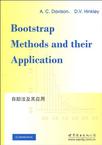自助法及其应用
出版时间:2010-4 出版社:世界图书出版公司 作者:(瑞士)戴维森 著 页数:582
Tag标签:无
前言
The publication in 1979 of BradIcy Efrons first article on bootstrap methods was amajor event in Statistics,at once synthesizing some of the cartier resampling ideasand establishing a new framework for simulation.based statistical analysis.The ideaof replacing complicated and often inaccurate approximations to biases,variances,and other measures of uncertainty by computer simulations caught the imaginationof both theoretical researchers and Users of statistical methods.Theoreticianssharpened their pencils and set about establishing mathematical conditions underwhich the idea could work.Once they had overcome their iuitial skepticism.appliedworkers sat down at their terminals and began to amass empirical evidence thatthe bootstrap often did work better than traditional methods.The early trickle ofPapers quickly became a torrent,with new additions to the literature appearingeverymonth nditwashardto seewhenwould be agoodmomenttotryto chartthe waters.Then the organizers of COMPSTAT 92 invited us to present a courseon the topic,and shortly afterwards we began to write this book. Wedecidedtotrytowriteabalanced account ofresamplingmethods,toincludebasic aspects of the theory which underpinned the methods,and to show as manyapplications as we could in order to illustrate the fun potential of the methods-warts and alL We quickly realized that in order for uS and others to understandand use the bootstrap,we would need suitable software,and producing it led usfurther towards a practically oriented treatment.0ur view was cemented by twofurther developments:the appearance oftwo excellent books,one bv PIeter Hallon the asymptotic theory and the other on basic methods bv Bradley Efron andRobert Tibshirani;and the chance to give further courses that included practicals.Our experience has been that hands-on computing is essential in coming to gripswith resampling ideas,so we have included practicals in this booL as well as moretheoretical problems. As the book fxpanded,we realized that a fully comprehensive treatment wasbeyond US,and that certain topics could be given only a cursory treatment becausetoo little is known about them.So it is that the reader will find only brief accountsof bootstrap methods for hierarchical data,missing data problems。model selection,robust estimation,nonparametric regression,and complex data.But we do try topoint the more ambitious reader in the fight direction.
内容概要
This series of high quality upper-division textbooks and expository monographs covers all areas of stochastic applicable mathematics. The topics range from pure and applied statistics to probability theory,operations research, mathematical programming, and optimzation. The books contain clear presentations of new developments in the field and also of the state of the art in classical methods. While emphasizing rigorous treatment of theoretical methods, the books contain important applications and discussionsof new techniques made possible be advances in computational methods.
书籍目录
Preface 1 Introduction 2 The Basic Bootstraps 2.1 Introduction 2.2 Parametric Simulation 2.3 Nonparametric Simulation 2.4 Simple Confidence Intervals 2.5 Reducing Error 2.6 Statistical Issues 2.7 Nonparametric Approximations for Variance and Bias 2.8 Subsampling Methods 2.9 Bibliographic Notes 2.10 Problems 2.11 Practicals Further Ideas 3.1 Introduction 3.2 Several Samples 3.3 Semiparametric Models 3.4 Smooth Estimates of F 3.5 Censoring 3.6 Missing Data 3.7 Finite Population Sampling 3.8 Hierarchical Data 3.9 Bootstrapping the Bootstrap 3.10 Bootstrap Diagnostics 3.11 Choice of Estimator from the Data 3.12 Bibliographic Notes 3.13 Problems 3.14 Practicals 4 Tests 4.1 Introduction 4.2 Resampling for Parametric Tests 4.3 Nonparametric Permutation Tests 4.4 Nonparametric Bootstrap Tests 4.5 Adjusted P-values 4.6 Estimating Properties of Tests 4.7 Bibliographic Notes 4.8 Problems 4.9 Practicals 5 Confidence Intervals 5.1 Introduction 5.2 Basic Confidence Limit Methods 5.3 Percentile Methods 5.4 Theoretical Comparison of Methods 5.5 Inversion of Significance Tests 5.6 Double Bootstrap Methods 5.7 Empirical Comparison of Bootstrap Methods 5.8 Multiparameter Methods 5.9 Conditional Confidence Regions 5.10 Prediction 5.11 Bibliographic Notes 5.12 Problems 5.13 Practicals 6 Linear Regression 6.1 introduction 6.2 Least Squares Linear Regression 6.3 Multiple Linear Regression 6.4 Aggregate Prediction Error and Variable Selection 6.5 Robust Regression 6.6 Bibliographic Notes 6.7 Problems 6.8 Practicals 7 Farther Topics in Regression 7.1 Introduction 7.2 Generalized Linear Models 7.3 Survival Data 7.4 Other Nonlinear Models 7.5 Misclassification Error 7.6 Nonparametric Regression 7.7 Bibliographic Notes 7.8 Problems 7.9 Practicals 8 Complex Dependence 8.1 Introduction 8.2 Time Series 8.3 Point Processes 8.4 Bibliographic Notes 8.5 Problems 8.6 Practicals 9 Improved Calculation 9.1 Introduction 9.2 Balanced Bootstraps 9.3 Control Methods 9.4 Importance Resampling 9.5 Saddlepoint Approximation 9.6 Bibliographic Notes 9.7 Problems 9.8 Practicals 10 Semiparametric Likelihood Inference 10.1 Likelihood 10.2 Multinomial-Based Likelihoods 10.3 Bootstrap Likelihood 10.4 Likelihood Based on Confidence Sets 10.5 Bayesian Bootstraps 10.6 Bibliographic Notes 10.7 Problems 10.8 Practicala 11 Computer Implementation 11.1 Introduction 11.2 Basic Bootstraps 11.3 Further Ideas 11.4 Tests 11.5 Confidence Intervals 11.6 Linear Regression 11.7 Further Topics in Regression 11.8 Time Series 11.9 Improved Simulation 11.10 Semiparametric Likelihoods Appendix A. Cumulant Calculations Bibliography Name Index Example index Subject index
图书封面
图书标签Tags
无
评论、评分、阅读与下载
用户评论 (总计2条)
- 章节分得很细,英文原著,很值得一看
- 专业指导书英文版,比在美国买便宜多了
